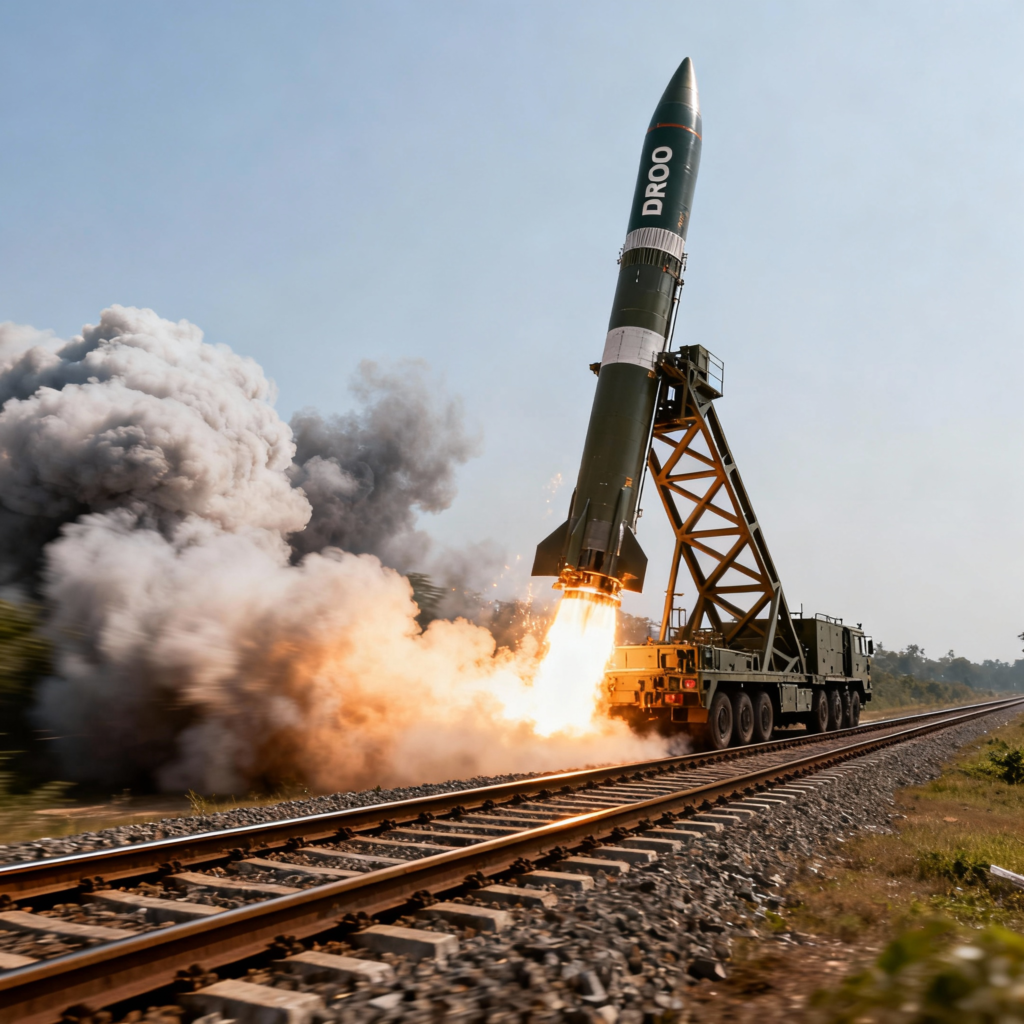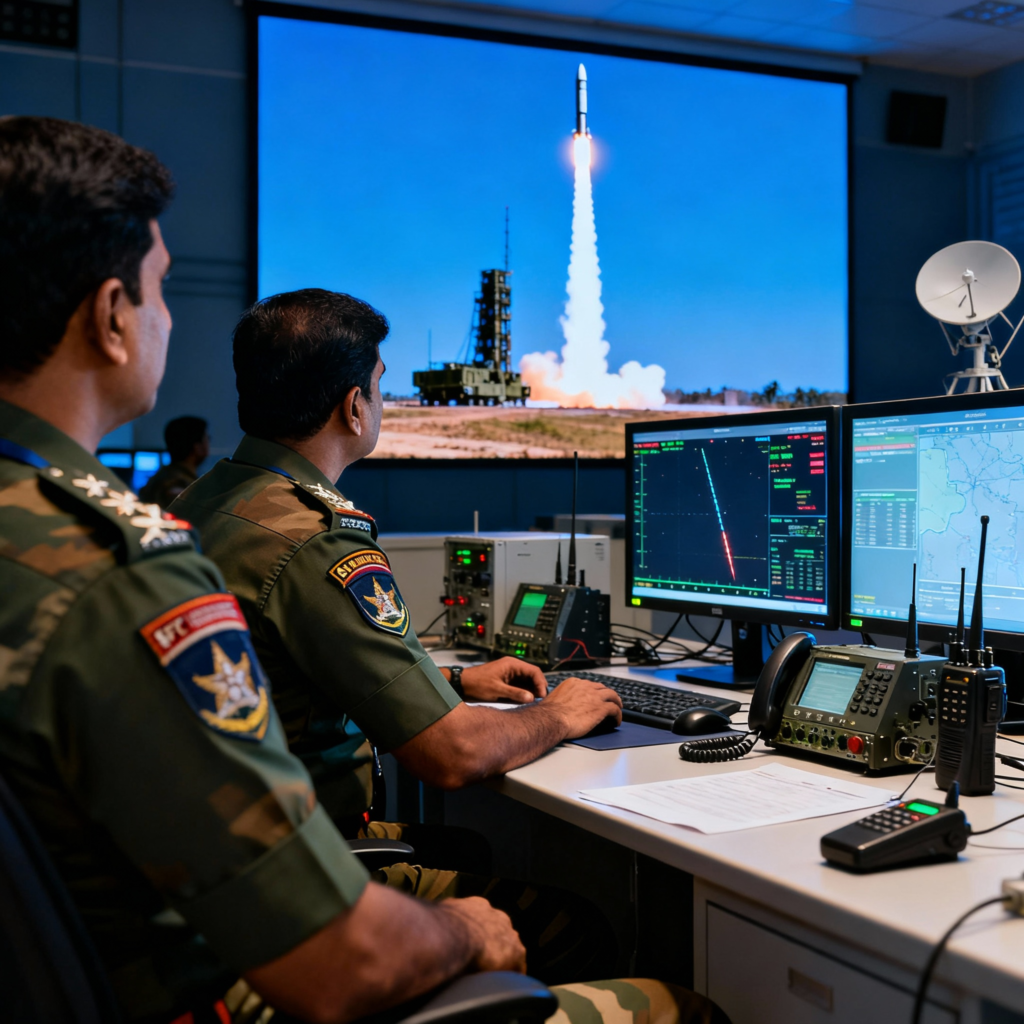Key Highlights
- Elite Club Membership: India joins exclusive group of 4-5 nations (US, Russia, China, possibly North Korea) with rail-based ballistic missile launch capabilities, marking major strategic milestone
- Revolutionary Mobility: 70,000-km Indian railway network provides unprecedented deployment flexibility, enabling launches from anywhere without preconditions and utilizing tunnels for concealment
- Advanced Canisterized Technology: Agni-Prime features sealed launch-ready containers, state-of-the-art communication systems, and independent launch capabilities with 2000-km range covering strategic targets
- Second-Strike Enhancement: Rail mobility significantly strengthens India’s “No First Use” nuclear doctrine by ensuring survivable retaliation capabilities even after absorbing first strike
- Textbook Success: September 24, 2025 test met all mission objectives with tracking by multiple ground stations, validating system for future service induction and operational deployment
A Game-Changing Milestone
On September 24, 2025, India achieved a historic defense milestone when the Defence Research and Development Organisation (DRDO) and Strategic Forces Command (SFC) successfully test-fired the Agni-Prime intermediate-range ballistic missile from a specially designed rail-based mobile launcher. This first-of-its-kind achievement places India among an elite group of nations – including the United States, Russia, China, and possibly North Korea – possessing rail-based missile launch capabilities.
Defence Minister Rajnath Singh hailed the test as a “textbook launch” that puts India in the “group of select nations having capabilities that have developed canisterised launch systems from on-the-move rail networks”. The successful launch represents a quantum leap in India’s strategic deterrence capabilities and demonstrates the nation’s growing indigenous defense technological prowess.

This revolutionary system leverages India’s extensive 70,000-kilometer railway network – the fourth-largest in the world – to provide unprecedented mobility, concealment, and survivability for strategic missile assets. The rail-based platform fundamentally alters the geometry of India’s deterrence posture by enabling rapid deployment from virtually any location across the country.
Evolution of India’s Strategic Missile Program
Agni Series Legacy and Development
The Agni missile series forms the backbone of India’s strategic nuclear delivery system, developed under the Integrated Guided Missile Development Programme (IGMDP) initiated in the 1980s. The series has progressively evolved from the 700-kilometer range Agni-I to the 5,500-kilometer intercontinental Agni-V, establishing India as a credible nuclear power. twz
The Agni-Prime (Agni-P) represents the next-generation advancement in this lineage, designed as a two-stage, solid-fuel missile with a range of up to 2,000 kilometers. Unlike its predecessors, the Agni-P incorporates advanced ring laser gyro-based inertial navigation systems, satellite augmentation technology, and improved accuracy while maintaining reduced weight and enhanced maneuverability.
Strategic Forces Command’s Critical Role
The Strategic Forces Command, established on January 4, 2003, serves as the operational arm of India’s Nuclear Command Authority (NCA). As a tri-service command led by a three-star officer, the SFC is responsible for managing, securing, and maintaining India’s tactical and strategic nuclear weapons.

The SFC’s role extends beyond mere operational control to encompass strategic planning, contingency preparation, and execution of nuclear directives under the explicit approval of the NCA. The successful rail-based launch demonstrates the SFC’s evolving capabilities in integrating advanced delivery systems with operational readiness.
Road-Mobile Success Foundation
The road-mobile version of Agni-Prime has already been inducted into service following a series of successful flight trials. This operational experience provided crucial technical foundations and confidence for developing the rail-based variant. The transition from road to rail mobility represents a natural evolution in enhancing survivability and deployment flexibility. pib
Revolutionary Rail-Based Launch System Features
Advanced Mobility and Deployment Capabilities
The rail-based mobile launcher represents a paradigm shift in strategic missile deployment philosophy. Unlike conventional road-mobile systems constrained by terrain, visibility, and logistical complexity, the rail platform integrates seamlessly into India’s vast railway network. This enables cross-country mobility without prior permissions or infrastructure modifications.
The system’s ability to move across the entire Indian rail network without preconditions provides unprecedented strategic flexibility. The launcher can rapidly relocate between diverse geographical regions, from Himalayan foothills to coastal areas, ensuring comprehensive territorial coverage.
Stealth and Survivability Enhancements
Concealment capabilities represent the system’s most significant strategic advantage. The rail-based launcher is designed to blend with civilian rail traffic, drastically reducing detection chances by adversary surveillance systems. This stealth mobility ensures survivability in first-strike scenarios and enhances second-strike credibility – a cornerstone of India’s nuclear doctrine.
India’s extensive railway tunnel network provides ready-made hardened bunkers for concealing missile launchers. These tunnels offer protection from satellite surveillance and potential enemy strikes while enabling rapid deployment when required. The system can remain hidden until the last moment, emerging only for launch operations.
Technical Specifications and Capabilities
The canisterized launch system allows the Agni-Prime missile to remain sealed in a launch-ready container, enhancing shelf life, improving safety, and enabling faster deployment. The canisterization technology represents a significant advancement over earlier generation missiles requiring extensive pre-launch preparation.
The launcher incorporates state-of-the-art communication systems, independent launch capabilities, and robust protection mechanisms. These features ensure operational reliability even in high-threat environments while maintaining secure command and control links with strategic headquarters.
Quick reaction capability enables launch within short timeframes with reduced visibility to adversary monitoring systems. This rapid response capability is crucial for maintaining credible deterrence in crisis situations.
Strategic Significance and Deterrence Enhancement
Nuclear Triad Strengthening
The rail-based Agni-Prime significantly strengthens India’s nuclear triad by providing a third dimension of land-based mobility complementing fixed silos and road-mobile systems. This diversification enhances the survivability of India’s nuclear arsenal by complicating adversary targeting calculations.
The system directly supports India’s “No First Use” nuclear doctrine by ensuring survivable second-strike capabilities even after absorbing a first strike. The enhanced survivability provided by rail mobility strengthens the credibility of India’s minimum deterrence posture.
Regional Strategic Balance
The rail-based Agni-Prime’s 2,000-kilometer range covers all of Pakistan and significant portions of southwestern China, addressing India’s primary strategic concerns. This comprehensive coverage from mobile platforms complicates adversary defensive planning while enhancing India’s strategic options.
For China, the system signals India’s intent to operationalize flexible deterrence across multiple fronts, including Himalayan and maritime theaters. The ability to launch from anywhere within the rail network means India can project deterrence deep into adversary territory without relocating fixed assets.
Credible Minimum Deterrence Framework
The rail-based system reinforces India’s credible minimum deterrence philosophy by ensuring survivable delivery capabilities under all scenarios. The mobility, concealment, and rapid deployment features guarantee that adversaries cannot eliminate India’s retaliatory capabilities through preemptive strikes.
This enhancement of second-strike credibility strengthens strategic stability by reducing incentives for first-strike scenarios while maintaining the threat of assured retaliation.
Stakeholder Ecosystem
DRDO Leadership and Technical Excellence
The Defence Research and Development Organisation has demonstrated exceptional technical competence in developing this first-of-its-kind system. The successful integration of missile technology with railway infrastructure represents years of dedicated research and innovative engineering.
DRDO’s achievement places India among global leaders in strategic missile technology while demonstrating indigenous capability in complex defense systems development. The organization’s continued investment in mobile platforms and advanced guidance systems ensures technological superiority in strategic domains.
Strategic Forces Command Operational Integration
The SFC’s participation in the rail-based launch demonstrates successful operational integration of advanced technology with strategic command structures. The command’s ability to coordinate complex operations across diverse platforms reflects institutional maturity and professional competence.
Future operational deployment will require extensive coordination between SFC, Indian Railways, and supporting agencies to ensure seamless integration with existing strategic forces.
Indian Railways Infrastructure Partnership
Indian Railways’ role as platform provider represents unprecedented civil-military cooperation in strategic defense applications. The railway network’s extensive coverage and established logistics capabilities provide ideal foundations for mobile strategic systems.
Technical modifications to railway infrastructure, including overhead wire management and specialized rolling stock, demonstrate innovative adaptation of civilian infrastructure for defense applications. This dual-use approach maximizes strategic value while minimizing additional infrastructure investment.
Implementation Challenges and Considerations
Technical Integration Complexities
Integrating missile systems with railway infrastructure presents unique technical challenges requiring specialized solutions. Overhead electrical wire management, launch blast effects, and precision targeting from moving platforms demand innovative engineering approaches.
Communication systems must maintain secure connectivity across diverse geographical terrains and varying operational conditions. Electronic warfare resistance and cybersecurity protection are critical requirements for maintaining operational security.
Security and Operational Secrecy
Movement coordination across multiple states and diverse terrains requires sophisticated security protocols to maintain operational secrecy. Intelligence agencies, local security forces, and railway authorities must coordinate seamlessly to prevent detection or compromise.
Operational security measures include false movement patterns, decoy operations, and communication security protocols to confuse adversary intelligence. These measures are essential for maintaining the system’s strategic advantage through concealment.
Regional and International Responses
Adversary responses may include enhanced surveillance capabilities, development of countermeasures, and potential arms race escalation. China’s deployment of tracking vessels in the Indian Ocean during the test indicates heightened interest in India’s strategic capabilities.
International implications require careful diplomatic management to prevent misinterpretation while demonstrating defensive intent and strategic restraint. Confidence-building measures and transparent communication can mitigate potential tensions while maintaining strategic advantages.
Conclusion
The successful rail-based launch of the Agni-Prime missile represents a watershed moment in India’s strategic defense evolution, demonstrating the nation’s growing technological sophistication and commitment to indigenous defense capabilities. This groundbreaking achievement not only enhances India’s deterrence posture but also validates decades of investment in indigenous research and development.
The strategic implications extend far beyond technical accomplishment, fundamentally altering regional balance and strengthening India’s position as a responsible nuclear power committed to strategic stability. The rail-based platform’s unique advantages in mobility, concealment, and survivability provide unprecedented flexibility in strategic planning while complicating adversary calculations.
India’s entry into the elite group of nations possessing rail-based missile capabilities reflects the maturation of its defense industrial base and strategic thinking. The integration of civilian infrastructure with strategic applications demonstrates innovative approaches to maximizing defense value while minimizing additional investment.
The successful test validates years of dedicated research by DRDO scientists and operational integration by the Strategic Forces Command, reflecting institutional excellence and professional competence. This collaborative achievement between defense agencies, railways, and supporting organizations exemplifies effective inter-agency coordination.
Future developments building on this technological foundation will likely include extended range systems, enhanced survivability features, and multi-platform integration capabilities. The potential for technology transfer and export opportunities may strengthen India’s position in global defense markets while generating economic returns.
However, the strategic environment requires careful management to prevent misinterpretation while maintaining deterrence credibility. Transparent communication about defensive intent and strategic restraint will be crucial for managing regional stability while preserving strategic advantages.
The rail-based Agni-Prime ultimately represents more than a technological achievement – it embodies India’s strategic maturity, technological capability, and commitment to maintaining peace through credible deterrence. As India continues its journey toward strategic autonomy and technological leadership, this milestone provides a solid foundation for future innovations and enhanced security.









+ There are no comments
Add yours